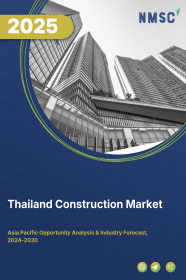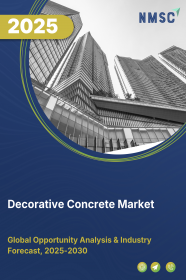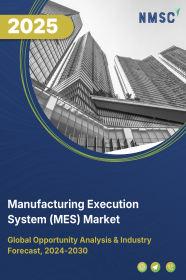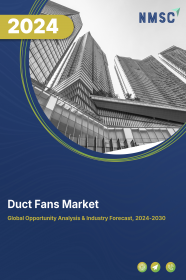
Thailand Construction Market by Type (Renovation, and New Construction), by Sector (Real Estate, Infrastructure, and Industrial), by Construction Method (Traditional Construction, Prefabricated/Modular Construction, 3D Printed Construction, and Green/Sustainable Construction), and by Type of Contractor (Small Contractor, Medium Contractor, and Large Contractor) – Industry Trends and Forecast, 2025–2030
Industry: Construction & Manufacturing | Publish Date: 20-Sep-2025 | No of Pages: 88 | No. of Tables: 117 | No. of Figures: 62 | Format: PDF | Report Code : CM2224
Thailand Construction Industry Overview
The Thailand Construction Market size was valued at USD 106.77 billion in 2024, and is projected to grow to USD 119.04 billion by 2025. Additionally, the industry is expected to continue its growth trajectory, reaching USD 182.41 billion by 2030, with a CAGR of 8.9% from 2025 to 2030.
Thailand construction market is experiencing substantial growth, driven by large-scale industrial projects such as the Laem Chabang Port expansion, the BYD electric vehicle production facility, and the U-Tapao International Airport expansion. These developments, alongside rising investments in infrastructure, particularly in energy and transportation, are propelling the sector forward.
However, regulatory complexities, including lengthy permit processes and inconsistent standards, continue to pose challenges, potentially delaying projects and increasing costs. On the other hand, the adoption of digital tools like Building Information Modeling (BIM), along with AI and IoT technologies, is offering new opportunities for enhanced project efficiency, collaboration, and resource management, further supporting the sector's growth.
Robust Economic Growth Accelerates Thailand’s Construction Demand
Thailand’s sustained economic development continues to drive rapid expansion across its construction sector. Increased government spending, rising consumer confidence, and foreign direct investment are creating strong momentum in residential, commercial, and infrastructure developments. As Thailand aims to become a high-income nation under its 20-Year National Strategy, public-private partnerships and capital inflows are fostering construction of mixed-use projects, industrial parks, and transit hubs. Economic hubs like Bangkok, Chonburi, and Rayong are witnessing steady construction activity, reflecting growing investor interest and long-term confidence in the Thai economy.
Urbanization and Population Growth Spur Infrastructure and Housing Projects
Thailand’s urbanization rate is rapidly increasing, with more citizens migrating to urban centers in search of better employment and living standards. Bangkok alone accounts for over 10 million people and continues to expand outward into neighboring provinces. This trend has resulted in a surge in demand for affordable housing, high-rise apartments, public amenities, and transportation infrastructure. In response, developers and government agencies are prioritizing large-scale urban projects—including transit-oriented developments and smart city plans—to improve connectivity, sustainability, and livability across urban regions.
Strategic Infrastructure Investments Drive National Development
Government-led infrastructure initiatives are central to Thailand’s construction boom. The country’s flagship Eastern Economic Corridor (EEC) is a prime example—featuring multi-billion-dollar investments in airports, seaports, railways, and smart cities. Projects like the high-speed rail link connecting Don Mueang, Suvarnabhumi, and U-Tapao airports and the expansion of Laem Chabang Port are transforming logistics and trade capabilities. In addition, mass transit expansions in Bangkok, such as the BTS Skytrain and MRT lines, continue to create sustained demand for both public and private sector construction activity. These long-term investments are set to stimulate job creation, attract foreign investment, and modernize Thailand’s infrastructure backbone.
Complex Regulatory Framework and Permitting Delays Hinder Construction Momentum
Thailand’s construction sector often faces delays and cost overruns due to a complex regulatory environment involving multiple layers of approval. Developers must navigate a maze of national and local regulations related to zoning, environmental impact assessments (EIA), building codes, and land-use laws. These bureaucratic hurdles can significantly slow project timelines, especially for large-scale infrastructure or urban development projects. Additionally, inconsistent enforcement of regulations across provinces and periodic changes in government policy can create uncertainty for both local and foreign investors. As a result, construction firms may face increased administrative costs and reduced investor confidence, delaying project initiation and execution.
Rising Construction Material Costs Challenge Industry Profitability
The steady increase in raw material prices in Thailand is putting pressure on the construction industry’s profit margins. Rising costs for steel, cement, concrete, and imported equipment—exacerbated by currency fluctuations and global supply chain disruptions—have made budgeting more unpredictable for developers and contractors. Local construction firms, particularly SMEs, face financial strain as they absorb higher input costs without proportionate increases in project budgets. These cost escalations may lead to stalled projects, reduced competitiveness in public tenders, and heightened financial risk, especially for long-term infrastructure projects with fixed contracts.
Digitalization and Bim Adoption Transforming Thailand’s Construction Landscape
Thailand’s construction industry is witnessing a digital shift, opening new avenues for efficiency and innovation. The growing adoption of Building Information Modeling (BIM) and smart construction technologies is enabling better project planning, real-time coordination, and lifecycle management. The Thai government has introduced BIM as a requirement for large-scale public projects to streamline processes and reduce errors. This digital push is further supported by smart city initiatives under the Thailand 4.0 policy, which encourages technology-driven development. Companies investing in automation, digital project management tools, and advanced data analytics are expected to gain a competitive edge in securing major contracts and improving delivery timelines, paving the way for a more modernized and resilient construction sector.
Competitive Landscape
The market players operating in the Thailand construction industry include Vinci, Colas, Fluor CorporationT, hai Development PCL, CH. Karnchang PCL, Sino-Thai Engineering and Construction PCL, Christiani And Nielsen (Thai) PCL, Unique Engineering and Construction PCL, Power Line Engineering PCL, Syntec Construction PCL, Pre-Built Public Company Limited, CAZ (Thailand) PCL, Thai Polycons PCL, Seafco PCL, NL Development and others.
Thailand Construction Market Key Segments
By Type
-
Renovation
-
New Construction
By Sector
-
Real Estate
-
Residential
-
Affordable
-
Luxury
-
-
Commercial
-
Retail Buildings
-
Office Buildings
-
Hospitality
-
Healthcare Facilities
-
Educational Institutes
-
Entertainment Ventures
-
-
-
Infrastructure
-
Transportation
-
Airport
-
Port
-
Rail
-
Road
-
-
Water and Wastewater
-
Energy
-
Telecommunication
-
-
Industrial
-
Manufacturing Plant
-
Warehouses
-
Power Plants
-
Oil Refineries
-
Chemical Plants
-
By Construction Method
-
Traditional Construction
-
Prefabricated/Modular Construction
-
3D-Printed Construction
-
Green/Sustainable Construction
By Type of Contractor
-
Large Contractor
-
Medium Contractor
-
Small Contractor
Key Players
-
Vinci
-
Colas
-
Fluor Corporation
-
Thai Development PCL
-
CH. Karnchang PCL
-
Sino-Thai Engineering and Construction PCL
-
Christiani And Nielsen (Thai) PCL
-
Unique Engineering and Construction PCL
-
Power Line Engineering PCL
-
Syntec Construction PCL
-
Pre-Built Public Company Limited
-
CAZ (Thailand) PCL
-
Thai Polycons PCL
-
Seafco PCL
-
NL Development
Report Scope and Segmentation
|
Parameters |
Details |
|
Market Size in 2024 |
USD 106.77 Billion |
|
Revenue Forecast in 2030 |
USD 182.41 Billion |
|
Growth Rate |
CAGR of 8.9% from 2025 to 2030 |
|
Analysis Period |
2024–2030 |
|
Base Year Considered |
2024 |
|
Forecast Period |
2025–2030 |
|
Market Size Estimation |
Billion (USD) |
|
Growth Factors |
|
|
Companies Profiled |
15 |
|
Market Share |
Available for 10 companies |
|
Customization Scope |
Free customization (equivalent up to 80 working hours of analysts) after purchase. Addition or alteration to country, regional, and segment scope. |
|
Pricing and Purchase Options |
Avail customized purchase options to meet your exact research needs. |

















 Speak to Our Analyst
Speak to Our Analyst





















